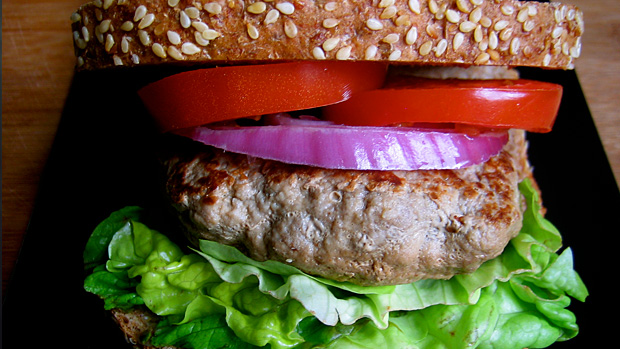The last time you and I were in the T Nation Clubhouse together, we were talking about buckling up our chinstraps and preparing for war against our most formidable opponent, our most hated rival, our sworn nemesis – Body Fat.
But before I send you out there through that tunnel to survive amongst wolves, I have some tough love truth to tell you.
Your chances of succeeding aren't good.
That's right. As a team, our fat loss quarterback rating sucks. Modern life has been throwing some crazy defensive packages and blitz schemes at us, and we're giving up sacks and throwing interceptions at a Brett Favre-ian rate.
Why did your last dieting attempt result in a shameful walk back to the sideline with nothing to show for it except a facemask full of dirt and a chorus of boo's from all your Facebook fans?
The initial answer from a lot of coaches is, "Well, because you're a P-word (another way to call a cat a kitty), and didn't stick to the game plan."
For a large percentage of the population, that's the cold honest truth. And the sad part is that's never going to change. Some just aren't cut out to make it in this league. It's tough, unforgiving, and owes you nothing. Our self-entitled generation will learn that lesson the hard way.
So maybe you need to hang up them cleats and consider picking up another hobby. I hear Zumba is fun.
But in some cases, maybe we just need a simple change in offensive strategy. We need to shake things up a little bit around this clubhouse to try to get the best out of our underperforming players.
Reestablishing Good Fundamentals
To me, there's no arguing over good food choices as the basis of any successful long-term plan, at least when it comes to the goal of merging health enhancement with physique enhancement.
This is the in the trenches type of work – good blocking and tackling – the dirty work up front that makes everything else possible. It's less glamorous, and doesn't get any of the media attention, but it's where 80% of the game is won or lost.
Many lose site of these basic fundamentals in search of wild trick plays and exotic offensive schemes. Listen, you could have the coolest play in the world designed and call it at the perfect time, but if your quarterback is lying face down in the dirt because you didn't take care of basic blocking and pass protection, you're not scoring any touchdowns.
And you definitely aren't scoring with the cheerleaders.
Caveman Meets Sports Nutrition
You know Miyaki's real food versus refined food and caveman meets sports nutrition philosophy, right?

Here's the simple game plan:
- Animal proteins for essential amino acids and essential fatty acids.
- Plants for fiber and micro's.
- Whole food fats as the primary energy nutrient for sedentary, insulin resistant, obese populations.
- A select few carbs (root vegetables and rice) as the primary energy nutrient for anaerobic exercisers.
- And of course, "High quality h30" from the great water boy, Bobby Boucher.
Crap like HFCS and gluten-based starches stay on the bench, except for a few trick plays every now and then for shits and giggles.
"But Nate, I've crap-loaded every night for the last 10 weeks and look good, and my biomarkers of health are peachy. It's all good, right?"
Dude, talk to me in 10 years.
Take it from someone who's worked with clients of all ages, former competitors, "beach bods" or performance athletes who were the shiznit in their heyday but are now severely overweight, on a bunch of medications, or have jacked themselves up (poor insulin sensitivity & blood glucose control, impaired hormone production) because their short-term plans ignored long-term consequences.
It's the cumulative effects of our dietary habits over a lifetime that matter, not any 10-week, or even 10-month time frame.

The Game Has Changed
Meal frequency and food distribution is another story, and it really comes down to finding a plan that gives you the best odds of succeeding. This is where we can study the game film and hit the chalkboard to come up with a better strategy.
Some people keep failing because of an approach that doesn't match their individual skill set. Don't play Refrigerator Perry as a slot receiver in a spread offense. Put that dude in the I-formation at the goal line and let him bulldoze in.
Much of this industry consists of full-time athletes writing plans for other full-time athletes, thinking that translates across the board to everyone, everywhere, and anyone who can't follow that plan is beneath them.
Anyone on T Nation will always be a full-time athlete in spirit until the day they die. I would never insult anyone by assuming otherwise.
But what if you're not a full-time athlete by profession anymore? There are only a lucky few who can make that dream a reality. And in some sports – powerlifting, strongman, bodybuilding, bar hopping, etc. – it's impossible to make a living from that sport alone, unless you think living in a van down by the gym is a real living.
What if you're an athlete who is also an entrepreneur running a full-time business, is coaching other athletes all day and night trying to get ahead, is slaving away at a demanding job to support his family, or is a full-time student building for the future, etc., (that's a real T-man by the way).
In other words, you want to get ripped for your personal mirror time, but you actually want to contribute something useful to society as well.
Life isn't as easy as it once was when you were living in your parents basement, and your only responsibility other than hitting the gym was playing World of Warcraft; or for older generations, Streetfighter; or for even older generations, Pac-Man; or for the dinosaurs, Uno.
Damn, those were the days, huh?
Maybe you need an approach that is more functional and sustainable given your crazy schedule and career demands, if you have any chance at succeeding the next time you take the field. After all, the game has changed.
The Meal Frequency Wars
There's no doubt that the meal frequency wars have replaced the carbohydrate wars. And there are passionate people on all sides of the Octagon.
Quite honestly, I don't get it, because the research is pretty clear – when controlling for food choices, calories, and macro's, meal frequency is irrelevant in terms of body composition change and the metabolic factors related to body composition change.
That's really just a fancy way of saying you can get equally good fat loss results eating 6, 3, or even 2 meals a day. Since that's the case, you can build your diet plan around your lifestyle, natural tendencies, career demands, time, and food availability, etc.
You can make the diet fit your life as opposed to the other way around. Which strategy do you think gives you a better chance at succeeding? Do what works for you with everything in life, not what anyone else deems is necessary.

Different Frequency Recommendations
Imagine there's a bell curve distribution of meal frequency patterns for being the most effective, functional, and sustainable for any given individual.
For simplicity's sake, let's say for 25% of the population, traditional fitness/bodybuilding nutrition patterns work best – 5 small meals/snacks a day, evenly spread.
It's become fashionable as of late to bash this approach. I myself am not innocent of such treachery, because some just can't let go of Spandex tradition, and refuse to believe there are any other viable methods outside of it.
So sometimes you have to argue the other side a little bit more aggressively, just to get people to snap out of dogmatic creeds.
But the unbiased reality remains it's a structure and approach that works well for many.
Just because something is unnecessary doesn't mean it's ineffective. The fact is, some people feel and perform better on more frequent feedings throughout the day, whether it is placebo effect or not. If this works for you – great, stick to it. You don't have to abandon ship.
The unbiased truth, however, is that this isn't a realistic, long-term fat loss structure for the majority, as displayed by real world results, even amongst athletic populations. And there's no need to stick to a plan that isn't working.
How many times can you get your ass kicked on the playing field before you realize you need to make a change?
Right in the middle of the curve, for say 50% of the population, the most functional approach is to base the diet on 3 protein-based meals a day. The traditional 3, but with much better food choices and meal composition. After all, this is the pattern that society and civilization has set up as the normal structure in most cultures.
For the final 25% of the population, the new, old trend of intermittent fasting has been a godsend. 10 years ago people thought Ori Hofmekler was a quack, although a few visionaries like Tim Patteron and TC gave him some space to share his views.
With the resurgence in popularity, various takes on intermittent fasting protocols have given many people who've struggled in the past with traditional fitness nutrition a more realistic and sustainable plan.
Guys like Berkhan, Ferruggia, Romaniello, Waterbury, Berardi, and yours truly, have since incorporated such offensive sets into their game plans (albeit with unique versions and tweaks), with Borat-like "great success!"
Statisticians amongst you, I don't proclaim these to be exact figures, just more of a breakdown of what I've seen personally. Is it completely earth shattering to acknowledge that different diets can work for different people?
The Franchise Players
Regardless of your chosen meal frequency, food distribution does matter – more so for the sustainability, practicality, and ease of plan than anything else.
These are my franchise players that I build the rest of my diet team around. Maybe you choose to build your team around others?
Player A should be a no-brainer: peri-workout nutrition. Use the predesigned protocol that fits your goals best at this time.
Player B is this: because human beings evolved on a fasting/feeding cycle, the brain works on a sacrifice/reward pattern. Most people can sacrifice and eat lighter/cut calories during the day if they know they can eat a complete meal at night and get to go to bed satiated, not to mention 90% of people's cheating comes at night.
Once you account for peri-workout nutrition, the most sustainable plans are the ones in which the majority of calories and energy nutrients (remember healthy fats for certain demographics, carbs for others) are eaten at night.
Don't hate the players, playa', hate the game.
This goes against everything you've probably ever heard about an optimal fat loss protocol, but guess what? It works well for many, because it goes beyond just pure physiology, which often is the least important factor to look at in terms of long-term diet success. It accounts for the psychological and social factors.
Then again, I'm not a doctor. I just play a gynecologist in real life. So believe whatever you want to believe.
Alternative Fat Loss Game Plans
Enough with the pontification, lets get down to some specific game plans we can implement in battle. Lets see how our team can use a variety of different formations, so we can find one that finally helps us win this damn game.
The Personnel (a targeted fat loss diet)
190-pound guy at 15% body fat
Lean body mass = 160 pounds
11 calories per pound of lean body mass = 1760 calories
1 gram protein per pound of lean body mass = 160 grams
20% calories from fats = 40 grams
Remaining calories from carbs = 175-200 grams
- Numbers are rounded and presented in ranges, so stop busting out your Texas Instruments, Dewey Decimal point calculators.
- This is just what I consider a good starting point. You may need more or less calories and carbs. Use whatever numbers you think are appropriate.
- This article is simply to demonstrate how the same personnel, whatever that may be, can be used in different formations.
Formation #1 – The Five-Wide Spread
Breakfast: 30-35 grams protein, 5-10 grams fat
Midmorn: 30-35 grams protein, 5-10 grams fat
Lunch: 30-35 grams protein, 5-10 grams fat
Midafternoon: 30-35 grams protein, 5-10 grams fat
- Up to this point, you can have any vegetables with your meals, and a piece or two of whole fruit (total for the day). All starches are saved for dinner.
- You can have more or less fat with each meal as long as you stay within the overall totals for the day.
Dinner: 30-35 grams protein, 5-10 grams fat, 125-150 grams carbs
Formation #2 – The Basic-Three Pro-Set
Breakfast: 50-55 grams protein, 10-20g fat
Lunch: 50-55 grams protein, 10-20 grams fat, 25-50 grams carbs (from fruit and vegetables only, no starch)
Dinner: 50-55 grams protein, 5-10 grams fat, 125-150 grams carbs
Formation #3 – The Two-Tight Fast
Breakfast: skip it
Lunch: 75-85 grams protein, 15-30 grams fat, 25-50 grams carbs (from fruit and vegetables only, no starch)
Dinner: 75-85 grams protein, 5-10 grams fat, 125-150 grams carbs
Peri-Workout Special Teams
On any days you train, regardless of the time of day, simply add your predesigned, peri-workout protocol. Everything else stays the same. Obviously, this gives you a little extra calories, protein, and carbs on your training days.
Upon Further Review
I can hear it now, "Miyaki, why don't you just pick a side already." My whole damn point is that there doesn't need to be sides. They all can work based on the individual situation.
But if you put a gun to my head and told me to tell you what I thought the best place is to start, I'd probably tell you to go with one of the reduced meal frequency approaches.
With food choices as the foundation, I've honestly gotten good results with all three plans, but from a practical standpoint, the Two-Tight Fast was the easiest to follow, and one I see as a long-term lifestyle plan, not just an in-season diet.
There are physiological reasons to lean towards that direction as well, but that's another film session for another time.
Fit the System to the Situation
I'm not a New England Patriots fan, but I've always admired Bill Belichick. He has the personality of a snail, but his coaching genius can't be denied. We've watched as the Patriot offense has molded over the years to fit the personnel at that time, thus giving their players the best chance at succeeding. They've won Super Bowls and broken records with different approaches.
It's gone from a pro-style set with some ground 'n' pound, to a spread offense with quick slot receivers, to a deep passing game, to their new two-tight intermediate passing game.
Much different from a system that insists you must run the Wildcat formation every single play, regardless of personnel.
Me? I'll use whatever formations and plays are necessary to beat what the defense is throwing at me. Obsessive athletes throw one defense at you, busy professionals throw another, and housewives will blitz every damn down like the Steelers. Sometimes you have to call an audible and change formations to get the first down and move the chains.
Take the Ball and Run With It
Some people cling to tradition, gurus, or systems like crabs to pubes. The problem with that approach is if you're always looking down, the view remains the same – shitty.
If what you're doing is working, than great. Don't change a thing. If not, I challenge you to try something new. Line up in a different formation and give it a go. You may just go from a benchwarmer to an All-Pro.




